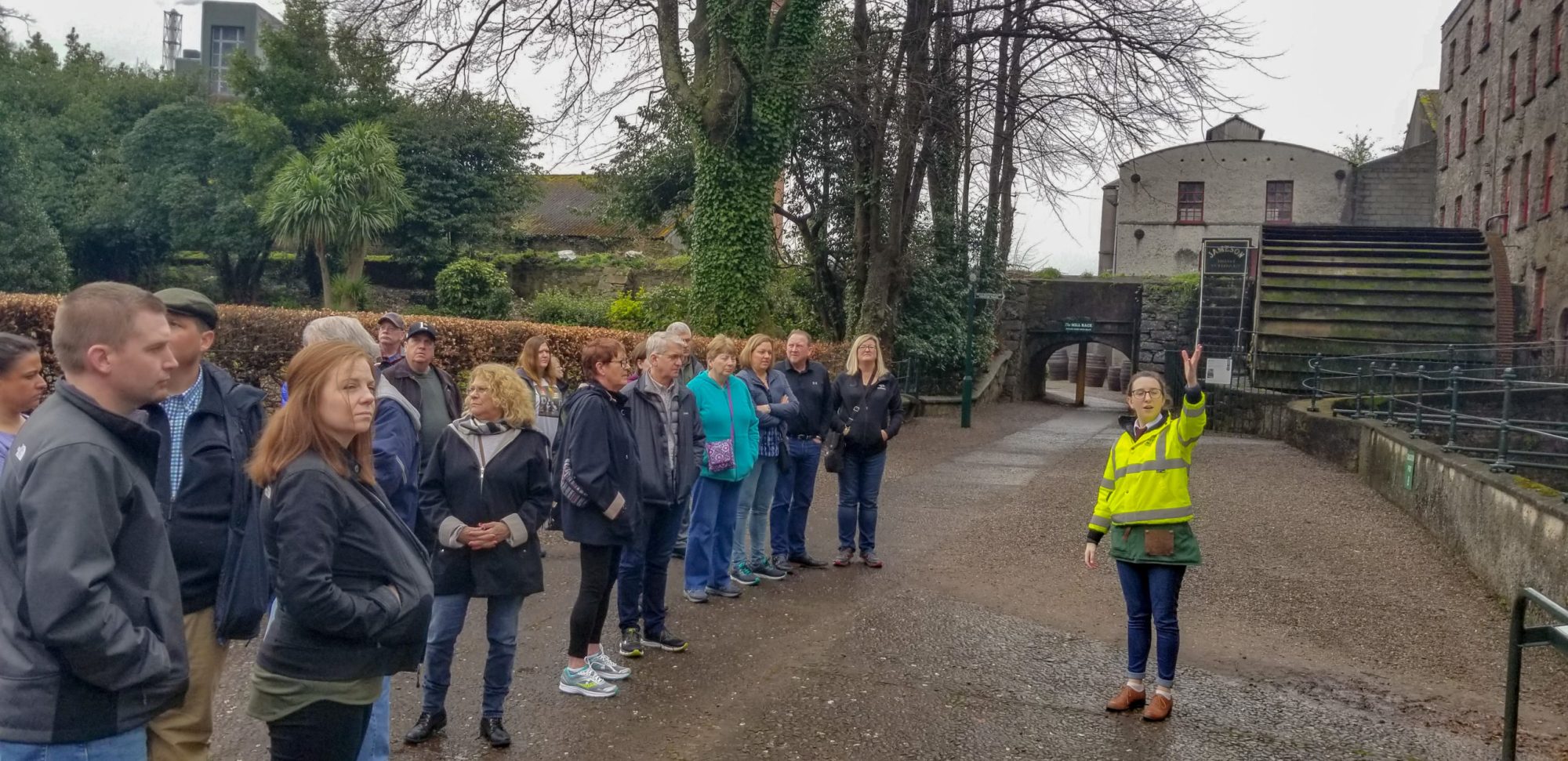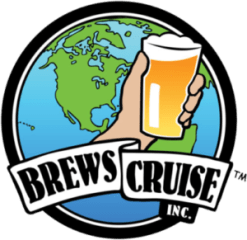Insider Experience: Ireland – Day Six Back to Dublin

Another night of fun in Cork City leads to the inevitable – the trip back to Dublin and the end of our Insider Experience: Ireland group trip. Along the way, we will visit two of the world-renowned Irish alcohol brands: Jameson Distillery and Guinness Brewery. There also is a very special surprise waiting in a Dublin pub. Now, the conclusion of our trip.
We enjoyed a comfortable Irish breakfast buffet in our hotel before bringing our bags down to the bus. A short half hour down the N25 brought us to Midleton, and the home of the iconic Irish Whiskey brand: Jameson.

Throughout the Jameson Distillery Experience Tour, we learned a very interesting back story of this company and much about the brands that they represent today. Here is a short history lesson about Irish whiskey.
Dublin was the center of Ireland’s whiskey production in the 1700 and 1800s. There were large distilleries like Powers and Teelings that were neighbors, just down the street from each other.
John Jameson – a Scotsman! – is the founder of Jameson Irish Whiskey. In 1786, he was managing the distillery that actually belonged to his wife Olivia’s family on Bow Street in Dublin. Two decades later he bought the family out, and along with his namesake son officially started the John Jameson and Son Irish Whiskey company.

By 1900, there were 90 distilleries in Ireland. For Jameson, they were producing a million gallons of spirits exclusively in wooden barrels at the turn of the 20th century. The brand was selling very well out of Ireland, especially in the UK and the United States. Everything was going great for them, but their fortunes took a drastic turn and the results would impact them for decades.
World War I (1914-1919) limited the export of Irish Whiskey to their key markets. Due to a German U-Boat blockade around Britain and Ireland, it made it very dangerous to export whiskey (or any goods) to the U.S. and to the British Empire.
The Irish War of Independence (1919-1921) had a disastrous effect on trade with Britain and the other states under the Commonwealth. By the time that conflict ended, America was well into their “Noble Experiment” of nationwide prohibition (1920-1933), the result being that important market for Irish Whiskey was now lost indefinitely.

The last battle was a very prolonged one involving different manufacturing methods. In 1830, an Irishman named Aeneas Coffey patented his designs to modify the existing column stills that would allow a greater portion of the distillate vapors to re-circulate into the still. The results of this were lighter spirits with higher alcohol content.
The Scots quickly embraced this vastly improved method of production. The Irish (especially Jameson) were reluctant to move away from their traditional pot stills as they found the results tasteless and bland. It would be many decades of watching Scotch whiskey gaining world acclaim before the Irish would reluctantly adopt the more modern methods. It’s important to note that the Coffey designs remain in every column still used ever since.
Not every distillery was able to recover from all of those blows, and others were lost due to impacts of World War II – even though Ireland remained neutral in that conflict.

In the 1960s, three out of the four distillers in Ireland that had survived these trying times – John Power & Son, John Jameson & Son, and the Cork Distilleries Company – came together to form a new company called Irish Distillers. In the 1970s, production for all three moved to the New Midleton Distillery in County Cork. The last solo distillery, Bushmills, joined the collaborative in 1972.
Pernod Ricard – a distilling company from France – bought out Irish Distillers in 1988 and still owns the brands today.
Much of that amazing history was covered in a brief introduction video before the group was brought through the former Malting House, Grain Store, Distilling Buildings, and Barrel Warehousing.

Noteworthy on the tour was the presence of a microdistillery which opened in 2015 in a stone warehouse on this site. This allows small batches to be tested before they make their way to the large production facility looming in the background of the Old Midleton Distillery.

At the end of our visit, a tasting of Scotch and American whiskeys showed that they could not hold up to the triple distilled and characteristically smooth flavor of Jameson Irish Whiskey. That is probably why Jameson is the Number One Irish whiskey brand in the United States (and 5th when compared to all whiskeys). Thanks to millennials, Irish Whiskeys are more popular now than they have been in a long time.

Back on the bus, we headed toward Dublin and a date with the legendary black stuff at St. James Gate.
We pulled up in front of the Guinness Storehouse and piled inside for our self-guided tour. A brief welcome to Guinness and overview of the facility was made while we were standing over the 9,000-year lease that Arthur Guinness signed in 1759.

The son of a farmer, Arthur Guinness first started an ale-only brewery in 1755 that was located in Leixlip – 10 miles to the west of Dublin.
Within five years he decided to leave there to start a new company in a vacant brewery site in Dublin. His younger brother Richard took the helm in Leixlip, and at the end of 1759 Arthur headed to the big city to sign the famous lease.
It appears that Arthur was once again making ales at his new brewery, tax records show the first entry for porter wasn’t recorded until 1778.

Arthur and his wife Olivia had 21 children together, but over half of them died at birth or before they reached adulthood. His second son, also named Arthur, joined his father in Dublin in the 1780s and became the senior partner in the brewery in 1803.
Throughout the majority of its history, Guinness produced only three variations of a single beer type: porter or single stout, double or extra stout, and foreign stout solely for export.
Today, Guinness is owned by Diageo and they produce hundreds of different alcohol brands and styles around the world. During our travels in Ireland for example, we saw the proliferation of the Hop House 13 lager which came out of the Guinness Open Gate Brewery, home to the Brewers Project experimental brewery.
Hop House 13 on lighted taps appeared to be more of a craft brand than as one owned by Guinness, and therefore Diageo. And we heard first-hand from small Irish craft brewers that getting tap space was very difficult when you are competing with the big dogs like Diageo and Heineken.
Our group took different paths to explore the former production brewery that now serves as the public face of the Guinness brand, We learned even more about the history of the Guinness family, how one of the world’s most popular beers is made, displays and models talking about their past distribution methods, and a look at their iconic advertising and marketing campaigns before we reached the top floor.

Perched on the roof of the Guinness Storehouse stands the Gravity Bar, the best place in the world to drink a pint of Guinness. The weather was perfect to look to the water source in the Wicklow Mountains, and to look over the original brewery site and the more modern facility nearby.
Seamus brought us to our well-positioned hotel, but we were not to stay there for long. Evan encouraged us to come right back down to hop on the bus for a final toast with the entire group before departures in the morning.
We piled into a place in Dublin’s Ranelagh Village called the TapHouse and headed upstairs to a private bar. At the very top of the stairs, everyone was surprised to get hugs from none other than Mark “Twig” Twohig of CANVAS brewery.

Twig had brought along a couple of the lads to join us from the Fortmoy Farm in Tipperary: Maurice and Michael Ruaidhri Deasy. And they brought along some of their beers, now tapped in this part of Dublin for the first time just for us.
Evan jumped behind the bar to start pouring beers…and with my vast Irish pub experience, I eagerly helped him. Toasts were made, beers and cheers moved easily throughout the room, and everyone talked about what their favorite parts of the fast-moving week were.

Tomorrow would be the departure day for all, but lasting will be the strong memories of the inaugural Insider Experience: Ireland group trip.
It certainly won’t be the last country to see us, as earlier in the day Evan announced plans for a new destination before the end of the year. More on that soon enough.
And much of the work has already been done for our March 2020 return to Ireland. Stay tuned for more details about these upcoming trips.
Slainte!
 Don Littlefield is the General Manager of Brew Bus Tours. This is his third visit to Ireland. He had a final pint of Guinness at McDaid’s Pub off of Dublin’s Grafton Street just before dreaming about writing this post. Twitter @BeerinME
Don Littlefield is the General Manager of Brew Bus Tours. This is his third visit to Ireland. He had a final pint of Guinness at McDaid’s Pub off of Dublin’s Grafton Street just before dreaming about writing this post. Twitter @BeerinME
